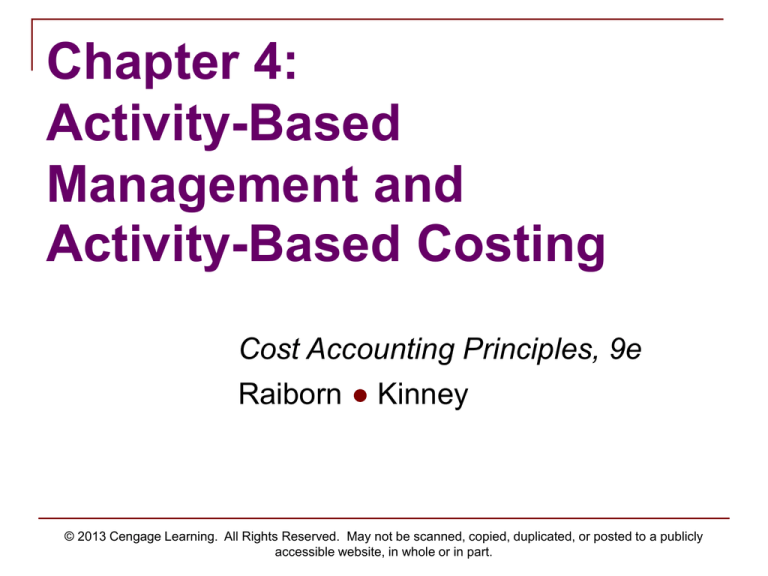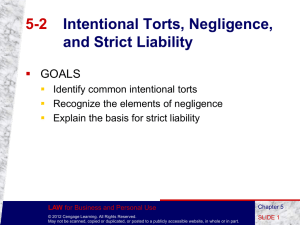
Chapter 4:
Activity-Based
Management and
Activity-Based Costing
Cost Accounting Principles, 9e
Raiborn ● Kinney
© 2013 Cengage Learning. All Rights Reserved. May not be scanned, copied, duplicated, or posted to a publicly
accessible website, in whole or in part.
Learning Objectives
In an activity-based management system, what are
value-added and non-value-added activities?
How do value-added and non-value-added activities affect
manufacturing cycle efficiency?
Why must cost drivers be designated in an activity-based
costing system?
How are product cost and service costs computed using
an activity-based costing system?
Under what conditions is activity-based costing useful in
an organization and what information do activity-based
costing systems provide to management?
What criticisms have been directed at activity-based
costing?
© 2013 Cengage Learning. All Rights Reserved. May not be scanned, copied, duplicated, or posted to a publicly
accessible website, in whole or in part.
Activity-Based Management
Focuses on activities during
production and performance process
An activity is a repetitive action
performed in fulfillment of a business
function
Improves the value received by
customers
Enhances profitability
© 2013 Cengage Learning. All Rights Reserved. May not be scanned, copied, duplicated, or posted to a publicly
accessible website, in whole or in part.
Activity-Based Management
Activity analysis
Operational control
Cost driver analysis
Quality management
Activity-based costing
Business process improvement
Continuous improvement
Performance measurement
© 2013 Cengage Learning. All Rights Reserved. May not be scanned, copied, duplicated, or posted to a publicly
accessible website, in whole or in part.
Activity-Based Management Benefits
External Benefits
Improved customer value
Enhanced profitability
Internal Benefits
More efficient production
More accurate cost determination
More effective performance evaluation
© 2013 Cengage Learning. All Rights Reserved. May not be scanned, copied, duplicated, or posted to a publicly
accessible website, in whole or in part.
Activity Analysis
Value-added activity
Increases worth of
product or service to a
customer
Customer is willing to
pay for it
Non-value-added activity
Increases time spent on
product or service but does
not increase worth
Unnecessary from
customer perspective
Can be reduced,
redesigned, or eliminated
without affecting market
value or quality
Business-value-added
activities are essential
© 2013 Cengage Learning. All Rights Reserved. May not be scanned, copied, duplicated, or posted to a publicly
accessible website, in whole or in part.
Cost Driver Analysis
Cost drivers are factors that have a
direct cause-and–effect relationship to
a cost
Limit the number of cost drivers
Cost of measurement should not exceed
benefit of using the cost driver
Easy to understand
Directly related to activity being performed
Appropriate for measurement
© 2013 Cengage Learning. All Rights Reserved. May not be scanned, copied, duplicated, or posted to a publicly
accessible website, in whole or in part.
Cost Driver Analysis
Unit-level costs
direct material, direct labor
Batch-level costs
setup, inspection
Product/process-level costs
engineering changes, product development
Organizational or facility costs
building depreciation, plant manager’s salary
© 2013 Cengage Learning. All Rights Reserved. May not be scanned, copied, duplicated, or posted to a publicly
accessible website, in whole or in part.
Activity-Based Costing
Recognizes several levels of costs
Accumulates costs into related cost pools
Uses multiple cost drivers to assign costs
to products and services
© 2013 Cengage Learning. All Rights Reserved. May not be scanned, copied, duplicated, or posted to a publicly
accessible website, in whole or in part.
Two-Step Allocation
Collect costs in general ledger and
subsidiary accounts
Identify activity centers
Accumulate costs into activity center cost
pools—cost drivers
Allocate costs to products and services
activity driver measures demands placed on
activities, thus the resources consumed by
products/services
© 2013 Cengage Learning. All Rights Reserved. May not be scanned, copied, duplicated, or posted to a publicly
accessible website, in whole or in part.
Traditional vs. ABC Costing
When ABC is implemented
Cost is reduced for high volume,
standard products
Cost is increased for low-volume,
complex specialty products
© 2013 Cengage Learning. All Rights Reserved. May not be scanned, copied, duplicated, or posted to a publicly
accessible website, in whole or in part.
Use ABC Costing for:
Product Variety and Process Complexity
Caused by mass customization
Too many choices, opportunity for errors
Pareto Principle
Commonality of parts
Reduced by
Simultaneous (or Concurrent)
Engineering
Design for Manufacturability
© 2013 Cengage Learning. All Rights Reserved. May not be scanned, copied, duplicated, or posted to a publicly
accessible website, in whole or in part.
Use ABC Costing for:
Lack of Commonality in Overhead Costs
-
Some products/services use substantially more
overhead than others
Problems with Current Cost Allocations
-
Significant changes in process with no change in
cost allocations
Expense majority of period costs when incurred
Changes in Business Environment
- Increase in competition or change in
management strategy
© 2013 Cengage Learning. All Rights Reserved. May not be scanned, copied, duplicated, or posted to a publicly
accessible website, in whole or in part.
Criticisms of ABC
Significant amount of time and cost
to implement
Must overcome barriers to change
Does not conform to GAAP
© 2013 Cengage Learning. All Rights Reserved. May not be scanned, copied, duplicated, or posted to a publicly
accessible website, in whole or in part.
Continuous Improvement
Eliminates non-value-added activities to
reduce cycle time
Makes products/performs services with zero
defects
Reduces product costs on an ongoing basis
Simplifies products and processes
ABC Costing Supports
Continuous Improvement
© 2013 Cengage Learning. All Rights Reserved. May not be scanned, copied, duplicated, or posted to a publicly
accessible website, in whole or in part.
Advantages of ABC and ABM
Identify and monitor significant technology
costs
Trace technology costs directly to products
Increase market share
Identify the cost drivers that create or
influence cost
Identify activities that do not contribute to
perceived customer value
© 2013 Cengage Learning. All Rights Reserved. May not be scanned, copied, duplicated, or posted to a publicly
accessible website, in whole or in part.
Advantages of ABC and ABM
Understand the impact of new technologies
on all elements of performance
Translate company goals into activity goals
Analyze the performance of activities across
business functions
Analyze performance problems
Promote standards of excellence
© 2013 Cengage Learning. All Rights Reserved. May not be scanned, copied, duplicated, or posted to a publicly
accessible website, in whole or in part.
Questions
What are the differences between activitybased costing and traditional cost
accounting?
What are cost drivers and activity drivers?
What are two advantages and two
criticisms of activity-based costing?
© 2013 Cengage Learning. All Rights Reserved. May not be scanned, copied, duplicated, or posted to a publicly
accessible website, in whole or in part.
Potential Ethical Issues
Ignoring non-value-added activities
Using non-value label to eliminate jobs
Misclassifying activities to allocate costs away from lower
volume products to justify lower selling prices
Selecting an inappropriate cost driver to distort cost
calculations
Using ABC to eliminate a vendor or customer
Using ABC to eliminate funding of social or environmental
causes
Using ABC to transfer cost from fixed price contracts to
cost-plus contracts
© 2013 Cengage Learning. All Rights Reserved. May not be scanned, copied, duplicated, or posted to a publicly
accessible website, in whole or in part.








